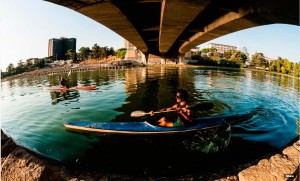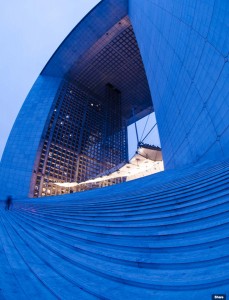Valeriano, a past student of mine sent me this photo to talk about. For a better understanding of where the photographer is coming from, and what his or her thought process was at the time, I like to copy exactly what they say when submitting. Another reason is that often is the case that others are thinking the same thing or have experienced similar situations.
Here’s what Valeriano had to say:
“Hi Joe,
I’ve recently broken your class rule for the fish-eye lens when composing this subject. Since also at dawn the monument wasn’t lit, the sky was dull gray and hazy with no clue of getting a single ray of dun at sunrise. I’ve also decided to break another of your class rules about white balance and set mine on Tungsten knowing I would get a bluish color cast on what wasn’t lit by artificial lights. Not having any one to model for me, I had to rely on pedestrians climbing the stairs in order to give a sense of scale by having a human figure in the composition.
Please let me know your thoughts, and-as-usual-thank you a lot for your invaluable critique and advice.
Cheers,
Ok Valeriano, let me first offer up a quote that was said by a very famous photographer named Ansel Adams. He said, “There are no rules for good pictures, there’s just good pictures”. In my online class with the PPSOP, and in my “Stretching Your Frame of Mind” workshops I conduct around the planet, I do have rules. These rules are only intended for my classes, not necessarily rules you have to live by. I have these rules because I’m a firm believer in teaching fellow photographers how to become stronger at their craft; by using their imagination not gimmicks.
To me, a good photographer doesn’t need to resort to specialty/trick lens or to wash everything in a specific color. A good photographer will rely on his wit, his ability to create good photos in the camera, and a knowledge of the elements of visual design and composition that he’ll get in my class. This has been my thinking for the past forty-six years and I’ve managed to take pretty good pictures without resorting to tricks or manipulation. I guess it’s all about being comfortable in my own skin. When I go out to shoot, I’m confident I’ll come back with something that will be timeless, memorable, and classic…but that’s just me.
In your photo, I hope that the people that view it loves blue, because it’s blue from corner to corner and edge to edge. Even the people you added for scale are blue!!! I’d be interested in seeing how it would look all yellow, or green, or even red? What I’d really like to have seen is this photo looking real. The reason is that you had all the elements to have created an interesting well composed photo that included several of the elements from my ‘Artist Palette’.
For example: Shape (the triangle at the top left), Pattern (the steps), Line (the lines you have that lead the viewer in and out of your frame), Tension (placing the people close to the edge of your frame), and Scale. In my opinion it would have been enough to carry it without turning everything blue.
As far as the Fisheye lens goes, there are definitely times when it’s used, for example in aerials or to solve industry related problems, but for me those times do not include the concept of “creativity”. In my opinion, the distortion is distracting, and there’s just not a place for it in the day to day world of picture taking.
 Here is another photo Valeriano shot with a Fisheye and submitted to me. For me, I think it’s an interesting picture that’s obviously well balanced and composed, and I’m sure that there will be people that will “ooh and aah” and there will even be people (usually friends or family) that will say…”Cool man”! If those are the people you’re trying to impress, then I say go for it and don’t take that lens off.
Here is another photo Valeriano shot with a Fisheye and submitted to me. For me, I think it’s an interesting picture that’s obviously well balanced and composed, and I’m sure that there will be people that will “ooh and aah” and there will even be people (usually friends or family) that will say…”Cool man”! If those are the people you’re trying to impress, then I say go for it and don’t take that lens off.
Again, that’s just one opinion, and now I want to leave you with this last thought, “If you have a hammer in your hand and everything looks like a nail, then you have a problem”.
As usual, thanks for sharing your photo and thoughts.
Visit my website at: www.joebaraban.com and check out my 2013 workshop schedule at the top of this blog. Come shoot with me sometime, but please…leave the Fisheye at home.
Don’t forget to send me a photo and question to: AskJoeB@gmail.com
JoeB






Joe,
just to make one thing clear: I never show my photography to relatives or friends, nor I ever relied on their judgment.
About the white balance and having a blue color cast on the first photo (it’s not all blue… artificial lights of the shape in center are in contrast with the color cast on what’s lit by dawn ambient light): it’s about mood.
I learnt this in a class from another photographer: Jim Zuckerman.
To me the real point of creativity in fisheye lens, lays in its own limit or flaw: the distortion. As well as many other creative things (not only in art) were achieved in history of man kind, not having the “sky as a limit”, but very hard and defined boundaries to cross.
Who’s successful between Icarus and Leonardo Da Vinci?
Valeriano,
Different strokes for different folks. It’s the essence of Art, wouldn’t you say? I promised I would never say that old cliche’… “Beauty is in the eye of the beholder”…so forget I said it!!!
🙂
JoeB
I can’t either understand what you meant with the metaphor of the hammer and the nails.
Moreover, I understand you self-promote yourself with this blog, but don’t you think it is a little too exaggerated when you say that knowledge of visual design and composition are get only in your class?
I’ve learnt about elements of visual design way long before being in your class.
Agreed.
I have a similar reaction when I see most Instagram pictures, cross-processed film, extreme-high-contrast B&W, etc. There are good uses for each of these, but they have been spoiled by over-use so now we need to use them all very carefully.
There’s a new photographic axiom in here somewhere, something like:
“Any technique that draws attention to the technique and away from the picture should not be used.”
Impressionists were accused of this very same thing… think about the color cast in shadows they introduced, and the reactions to that by the establishment of that time.
Just the fact that they were seeing things differently than the established painters of the time, was enough dissatisfaction among the ranks of critics to pretty much scoff at the likes of Cezanne’ and Renoir.
Having said that, I seriously doubt blue photos will test the time as well as the impressionists have.
JoeB
I am not so vain and narcissistic to think that my photography would ever test the times.
I was speaking in general about the very narrow mind set approach of this commenter regarding Instagram (which is the lazy way to Lomography).
Otherwise I wouldn’t even submit my stuff to your critiques, what do you think?
Valeriano,
I really don’t have an opinion on Instagrams since they never enter into my mind as far as being considered in the same vein as real photographs. It’s like going out with a plastic toy camera and having fun with it. It’s two separates things for me. I also love taking quick photos with my iPhone and sending them to friends and family, but I would never seriously consider it as a way to take the real stuff!!!
Having said that, I’m absolutely 100% behind experimentation and looking at things all kinds of ways. I’ve often fooled around in Photoshop to see how many ways I can make one of my photos look different. However, I always go back to the classic approach to photography. That’s what happens when you get old and gray, so whatever you can do to avoid it would be in your best interest.
Btw, the Impressionists were my favorite, even when I was a teenager studying at the Kansas City Art Institute.
🙂
JoeB
Well actually the plastic toy cameras of Lomography makes you really apply a lot to become creative.
The huge limitations that kind of media has, really pushes you to think differently and see things differently. It also forces you to calculate exposures in your head or using a chart, which will either push you to see as a camera sees.
Do you know Dr Marteen’s boots brand? Well they had a whole marketing year done with Lomography. Thus Lomography also sells. Not bad for a piece of plastic loaded with medium format film in 21st century.
Regarding Photoshop: I don’t use it to experiment, it’s just part of the new concept of workflow for photography in this digital era. You get some RAW material which you have to develop yourself. Otherwise, rely on automatic picture renders from your camera (I already explained you that I won’t ever let an electronic device take artistic choices on my behalf).
Now, if the RAW material you get in camera is as good as possible —that is why I’d never sayd or will ever not agree with the statement: get pictures in camera— the workflow to develop it will be much lighter and faster.
PS I thought you were from Texas, not from Kansas.
I think you’re missing the point about toy cameras.
Btw, I will never stop trying to get my photos “in the camera”…until the day they pry my dead cold fingers off the shutter release.
Joe
You might show me where I said that they could only be received in my class.
I was studying these elements long before I wads a photographer, and long before you were born. Maybe when you’re parents were playing outside.
As far as the metaphor is concerned, you’re a smart kid Valeriano, you’ll figure it out.
JoeB
“To me, a good photographer doesn’t need to resort to specialty/trick lens or to wash everything in a specific color. A good photographer will rely on his wit, his ability to create good photos in the camera, and a knowledge of the elements of visual design and composition that he’ll get in my class.”
Ok let me get this straight: your class were really good. I loved them and I’d learnt many things. But not so much about visual elements of design. At least not as much as I did in other classes I took before yours.
Don’t take it personally, but in your classes there’s a lot of stuff going on, and elements of visual design deserve at least a couple of specific classes, dedicated in full to them. That’s if you’re trying to really teach and “mentor” people. Otherwise you’re just scratching the surface and being autocratic.
I think we’re done with this conversation, but thanks for your advice, I’ll keep in in mind.
JoeB
Jim,
Thanks for your input. Forums are great because everyone will get something out of it…please keep them coming.
Ok, I’m not sure i would put Instagrams in the same genre as a camera I would take out hunting for serious photo opts. I suppose they have a place in our new “social media”..right next to texting and tweeting!!!.
Btw, I’ve heard that axiom, and love it!!!
JoeB
Hello Joe I usually do not like to comment on other photographer’s photos they send to you, but I hope I can add something to this discussion. First I agree with Joe on the use of the fish eye lens. When I think of that lens the shot of the skateboarder jumping over the camera in a dry swimming pool always comes to mind. Yes it can look neat and cool but its just an effect that does not need to be used that much. Secondly, many of the greatest photographers used The standard lens specifically because it kept lines straight. It is no accident many of the most famous photographs were shot using the plain ole 50mm lens.
Ok now for for the use of all that blue color in the photograph. Unless you feel very strongly about always using extreme color in your personal work, then it should be avoided. In my opinion. I mean Henri Matisse used very vivid colors in his work and people did not like it at the time. But Matisse believed in what he was doing, kept painting that way, and look at how much the art world loves him now.
So in the end I agree with Joe. Try to learn shape, pattern, line, tension and scale. Use these design tools to frame up your shot and use a lens that keeps the lines straight.
Gary,
thanks for your input. It makes for a great forum where everyone gets something out of it. Keep it coming!!!
JoeB
I have only taken formal photography classes from one instructor his name is John Free. He is over 70 70 years old and has been a photographer for over 40 years. Here is his take on the Holga (or plastic toy cheap camera). Photography is not bullshit running around with these ridiculous cameras, a plastic camera intentionally trying to degrade the image in an attempt to be arty. Come on! I agree with this completely.
Gary,
I could not have said it better. Thanks!!!!!
JoeB